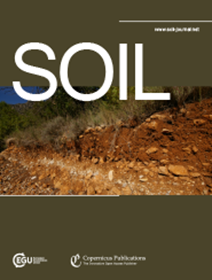前冰期湿地:在最近冰川消融的景观中被忽视的二氧化碳汇
IF 4.3
2区 农林科学
Q1 SOIL SCIENCE
引用次数: 0
摘要
摘要。在过去的150年里,冰川消融使欧洲阿尔卑斯山脉出现了大片陆地。由于温度低、缺乏水分和生长季节短,这些地区的土壤形成被认为是缓慢的。然而,以前的研究只关注干燥的土壤,忽略了任何水分饱和的地方。我们的研究表明,这些水饱和位置是前冰期山谷二氧化碳吸收的关键位置,并且在碳储存中具有重要作用,尽管它们的表面积很小。燃烧损失分析显示,某些湿地土壤含有高达85%的碳,这表明随着时间的推移,这些湿地可以变成泥炭地,储存大量的碳。二氧化碳通量测量显示了所有测量年龄的湿地的大气二氧化碳吸收量,甚至在冰川消退后5年。由于在50年的地点通常观察到很少的苔藓或植物覆盖,自养微生物群落可能在这些幼嫩系统中起重要作用。非饱和地点的二氧化碳通量变化大得多,不同年龄的地区都观察到二氧化碳的排放和吸收。总体而言,我们的研究表明,湿地是前冰期地区生物活动和成土过程的热点,因此应该在前冰期研究中得到更多的关注。本文章由计算机程序翻译,如有差异,请以英文原文为准。
Proglacial wetlands: an overlooked CO2 sink within recently deglaciated landscapes
Abstract. Glacial retreat has uncovered vast landmasses in the European Alps over the last 150 yrs. Soil formation in these areas is considered to be slow due to low temperatures, lack of moisture, and short growing seasons. Previous studies have however focused solely on dry soils, omitting any water saturated locations. Our research shows that these water saturated locations are key locations of CO2 uptake and have a significant role in carbon storage in the proglacial valley, despite their small surface area. Loss-on-ignition analyses showed certain wetland soils contained up to 85 % carbon, suggesting these wetlands can become peatlands over time, storing large amounts of carbon. CO2 flux measurements showed atmospheric CO2 uptake in wetlands of all measured ages, even as young as 5 years after deglaciation. As little moss or plant cover was generally observed at locations <50 yrs, the autotrophic microbial community likely plays an important role in these young systems. Non-saturated locations showed a much larger variation in CO2 fluxes, with both emission and uptake of CO2 being observed across ages. Overall, our research shows that wetlands are hotspots of biological activity and pedogenic processes in proglacial areas and should therefore receive more attention in proglacial research.
求助全文
通过发布文献求助,成功后即可免费获取论文全文。
去求助
来源期刊

Soil
Agricultural and Biological Sciences-Soil Science
CiteScore
10.80
自引率
2.90%
发文量
44
审稿时长
30 weeks
期刊介绍:
SOIL is an international scientific journal dedicated to the publication and discussion of high-quality research in the field of soil system sciences.
SOIL is at the interface between the atmosphere, lithosphere, hydrosphere, and biosphere. SOIL publishes scientific research that contributes to understanding the soil system and its interaction with humans and the entire Earth system. The scope of the journal includes all topics that fall within the study of soil science as a discipline, with an emphasis on studies that integrate soil science with other sciences (hydrology, agronomy, socio-economics, health sciences, atmospheric sciences, etc.).
 求助内容:
求助内容: 应助结果提醒方式:
应助结果提醒方式:


